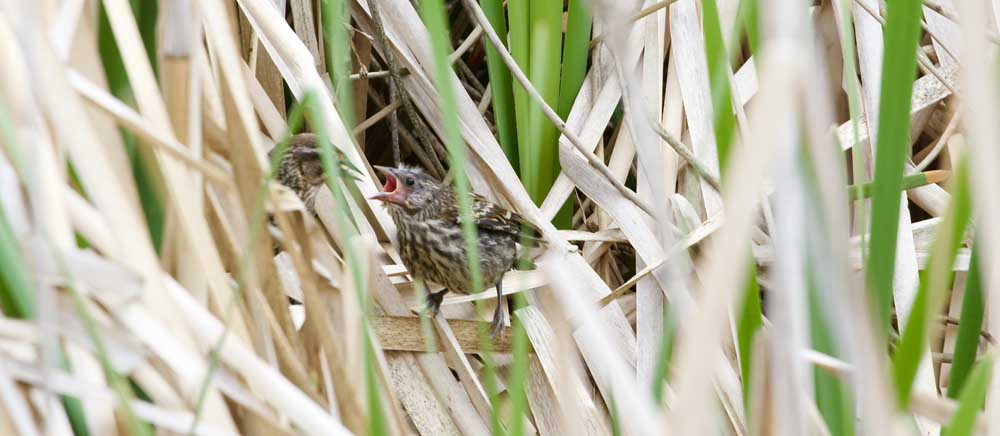Birding: ‘Tis the season for ‘Konk-a-ree! Konk-a-Ree!’
Published 8:12 am Sunday, March 12, 2023

- Female red-winged blackbird and her hungry baby. Her bill is filled with insects which she is about to feed to her youngster.
“Konk-a-ree, konk-a-ree” is the sound I associate with a blackbird you should soon be seeing in yards, at feeders, in marshes, and in other wetland areas. Male red-winged blackbirds will soon be on hand to claim territory. As they defend their territories they will puff up and spread their wings showing off their red and yellow epaulettes.
Trending
Red-wing males are polygynous, which means that males mate with several females. Scientists indicate that mating with ten or more females is not unusual. The Cornell Lab of Ornithology reports that “typically five or more females cluster their nests together in the chosen male’s territory” (2017). These males will be the healthiest birds. They will also be the best competitors for the available resources. As expected, the healthiest red-wing males are the ones that will attract more female mates compared to those with poorer qualities.
No injuries were ever sustained, but everyone learned to be careful and respect the presence of the resident red-wing blackbird!
Male red-winged blackbirds have a loud, raucous call. Their “konk-a-ree, konk-a-ree” can be heard all over their chosen area as the males let loose to claim territory. Getting in the way of a red-wing’s territory often has consequences. They may bombard other red-winged blackbirds who stray into their claimed area and may even fly at humans who do so. I have experienced this first-hand. The sidewalk from the parking lot to my office was too close for one red-winged blackbird that nested in the reeds and bulrushes of the nearby pond. Students and professors, including myself, were often treated to aerial attacks during the breeding season. No injuries were ever sustained, but everyone learned to be careful and respect the presence of the resident red-wing blackbird! Female red-winged blackbirds also give off harsh sounds especially when other females come too close.
Males usually arrive on territory followed by the females. Their arrival can be anytime up to a month afterwards. Red-winged blackbirds that live in the north tend to be migratory, while southern or western populations tend to stay in place. In other words, they are more likely to be permanent residents. Their migration behavior is interesting. According to science, red-winged blackbirds migrate during the day rather than at night like other bird species. This behavior allows them to avoid the issues that can be encountered during night migration such as flying into tall well-lit buildings in cities.
Red-winged blackbirds nest in marshes and other places such as fields, usually near water or a wetland. The nest is made of plant material which the female winds around the stems of reeds or bulrushes that sport a platform. It is cup shaped, lined with mud and fine dry grasses. They may also nest in a bush nearby the wetland. Females produce one or two broods during the breeding season. It is interesting to note that when red-winged blackbirds nest in the same wetland as the yellow-headed blackbird that the more aggressive yellow headeds choose the best nesting spots and relegate the red-winged blackbirds to the outside edges of the wetland which are not as safe or protected as the middle.
Red-winged blackbirds are one of the most widespread birds in North America. They have fared well despite the loss of wetlands, their preferred habitat. In fact, many years ago when I was collecting nesting data in the province of Ontario, Canada, it was reported that one enterprising red wing built a nest in the subway! Red-winged blackbirds will soon be back in large numbers. Listen for and enjoy the ringing “Konk-a-ree” of the red wings as they begin to announce their arrival on the peninsula. Happy birding.









